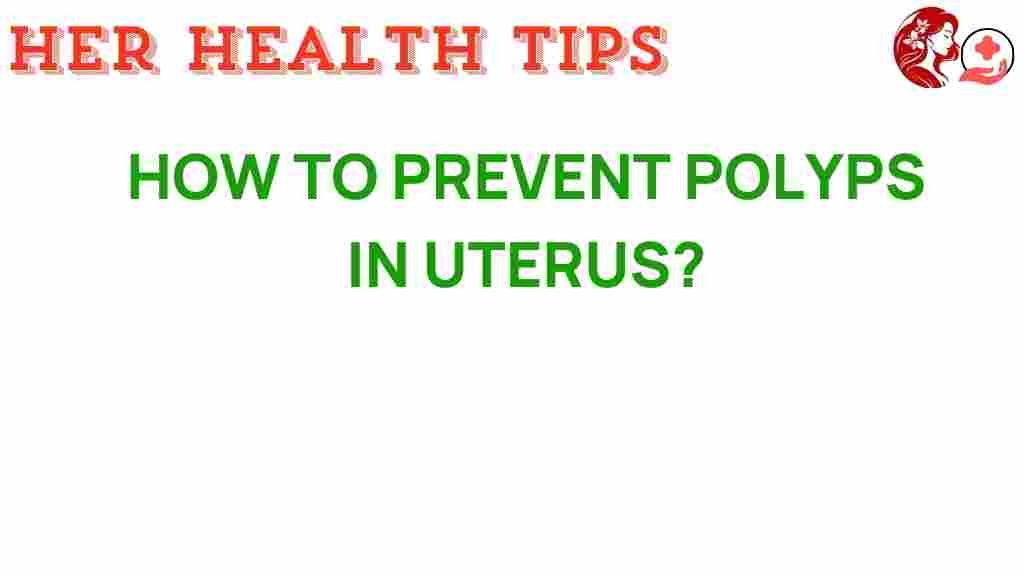Unraveling the Secrets: How to Prevent Uterine Polyps
Uterine polyps are benign growths that develop on the lining of the uterus. They can vary in size and number, and while they are often asymptomatic, they can lead to various health issues if left untreated. Understanding how to prevent uterine polyps is crucial for maintaining optimal women’s health. This article will explore effective prevention strategies, symptoms, diagnosis, treatment options, and lifestyle changes that can help you keep your reproductive health in check.
Understanding Uterine Polyps
Uterine polyps are small, finger-like projections that can occur on the inner wall of the uterus. They are often associated with hormonal imbalances, particularly involving estrogen. While benign, these growths can cause complications such as abnormal bleeding, infertility, and discomfort.
Common Symptoms of Uterine Polyps
Recognizing the symptoms of uterine polyps is essential for early diagnosis and treatment. Common symptoms include:
- Irregular menstrual periods
- Heavy menstrual bleeding
- Bleeding between periods
- Bleeding after menopause
- Pain during intercourse
- Infertility issues
If you experience any of these symptoms, it is important to consult with a healthcare provider for further evaluation.
Diagnosis of Uterine Polyps
Diagnosing uterine polyps typically involves a combination of the following methods:
- Pelvic Exam: A healthcare provider will perform a physical examination to check for abnormalities.
- Ultrasound: A transvaginal ultrasound can help visualize the uterus and detect polyps.
- Hysteroscopy: This procedure allows direct visualization of the uterine cavity using a hysteroscope.
- Biopsy: In some cases, a biopsy may be performed to rule out cancer.
Treatment Options for Uterine Polyps
Treatment for uterine polyps depends on the size of the polyps and whether they are causing symptoms. Options include:
- Watchful Waiting: If polyps are asymptomatic, a doctor may recommend monitoring them.
- Medications: Hormonal treatments may help manage symptoms associated with uterine polyps.
- Surgical Removal: Hysteroscopic polypectomy is a common procedure to remove polyps.
Prevention of Uterine Polyps
While not all uterine polyps can be prevented, certain lifestyle changes and health tips can significantly reduce the risk. Here are some effective ways to prevent uterine polyps:
1. Maintain a Healthy Weight
Obesity and excess body fat can lead to hormonal imbalances, increasing the risk of developing uterine polyps. Aim for a balanced diet and regular exercise to maintain a healthy weight.
2. Eat a Balanced Diet
A diet rich in fruits, vegetables, whole grains, and lean proteins can help regulate hormone levels. Consider incorporating the following foods:
- Leafy greens (e.g., spinach, kale)
- Fruits (e.g., berries, citrus)
- Whole grains (e.g., brown rice, quinoa)
- Lean proteins (e.g., chicken, fish)
3. Limit Processed Foods and Sugars
Reducing the intake of processed foods and sugars can help maintain balanced hormone levels and reduce inflammation. Aim to limit:
- Sugary snacks and beverages
- Refined carbohydrates
- High-fat processed meats
4. Exercise Regularly
Regular physical activity can help regulate hormones and maintain a healthy weight. Aim for at least 150 minutes of moderate exercise per week, including:
- Walking
- Swimming
- Cycling
- Strength training
5. Manage Stress
Chronic stress can lead to hormonal imbalances that may contribute to the development of uterine polyps. Consider incorporating stress-reducing techniques such as:
- Meditation
- Yoga
- Deep-breathing exercises
- Journaling
6. Regular Check-ups
Routine gynecological exams can help detect any issues early on. Discuss any concerns or symptoms with your healthcare provider during your visits.
7. Avoid Hormonal Imbalances
Hormonal imbalances can lead to the development of uterine polyps. Discuss with your doctor the best ways to maintain hormonal balance, especially if you have conditions like polycystic ovary syndrome (PCOS) or endometriosis.
Step-by-Step Process for Monitoring Your Health
To effectively prevent uterine polyps and maintain overall women’s health, follow this simple step-by-step process:
- Schedule Regular Check-ups: Make appointments with your healthcare provider for routine gynecological exams.
- Track Your Menstrual Cycle: Keep a diary of your menstrual cycle, noting any irregularities.
- Implement Healthy Lifestyle Changes: Adopt a balanced diet, regular exercise, and stress management techniques.
- Consult a Specialist: If you experience symptoms of uterine polyps, seek an evaluation from a gynecologist.
- Consider Alternatives: Discuss with your doctor any potential hormonal treatments or lifestyle modifications.
Troubleshooting Tips for Common Concerns
Here are some troubleshooting tips for common concerns regarding uterine polyps and women’s health:
- If you experience heavy bleeding: Keep track of your menstrual flow and discuss any changes with your doctor.
- If you have pain during intercourse: Consult with a healthcare provider to rule out any underlying conditions.
- If you are trying to conceive: Seek advice from a fertility specialist if you suspect uterine polyps may be affecting your fertility.
Conclusion
Preventing uterine polyps is an important aspect of maintaining women’s health. By understanding the risk factors, symptoms, diagnosis, and treatment options, you can take proactive steps to reduce your risk of developing these growths. Lifestyle changes such as maintaining a healthy weight, eating a balanced diet, exercising regularly, and managing stress can significantly contribute to prevention. If you have any concerns or experience symptoms, consult with a healthcare provider for appropriate evaluation and management.
For more information on women’s health, visit Women’s Health Foundation. To read about fibroids and their impact, check out this helpful resource.
This article is in the category Reproductive and created by HerHealthTips Team
